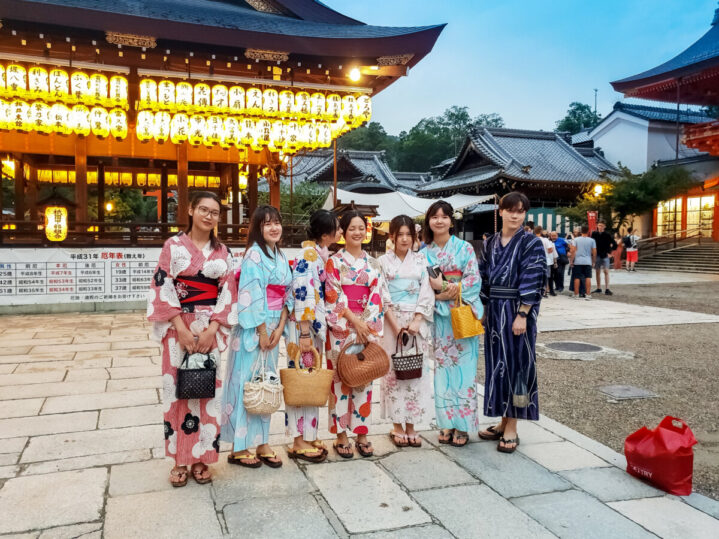
Enchanting one on one with a geisha apprentice
I’ve always had this fascination for geishas. Their life is a mystery to me. The overall personality, their history and story seem to be very interesting and exciting. They are elusive and perplexing but how and where to find them isn’t easy because I was told that one has to be invited to a teahouse by a prominent person to be able to see an aspiring geisha. In Kyoto a geisha is called Geiko and a Maiko is an aspiring Geiko apprentice. I deliberately chose and stayed in Gion, an old world district in Kyoto known to be famous not just for traditional wooden houses (Machiya) but for the birthplace of the geiko and maiko culture. Immediately after I unload my things in my hotel room, I joined a walking tour that night in the hope to see one because they are often spotted around eleven in the evening after their work in tea houses or private homes. I am one of those people who thought that maikos are sold to this industry and I am here to find out the truth about them. Reading about them gave me that feeling of wanting to know more and to confirm if the stories I’ve read and the movies about them that I’ve seen are accurate. There were a lot of misconceptions about maikos that I would rather know reality from fantasy or works of a writer’s imagination.
 Just as I thought, It’s not easy to find geikos and maikos around the streets of Gion in Kyoto. It took us two hours of walking around the alleys and the only thing I’ve seen are Japanese women and tourists clad in kimonos to my utter disappointment. Kimono wearing Japanese women in Japan has become scarce that the government started promoting the wearing of kimonos. Every nook and cranny has kimono rental shops where men and women can rent a complete kimono ensemble for five thousand yen or fifty dollars. In return, they get discount in stores and restaurants as an incentive. Tourists take advantage of this by renting kimonos during their stay in Japan and they swear that it’s comfortable and they get a lot of attention on top of having their pictures taken as a remembrance of their visit to Japan. But these are not what I was seeking. Until from out of the blue a beautiful maiko appeared she seemed to be in a hurry so like a paparazzi, I took her photo. That walking tour wasn’t such a bad idea after all.
Just as I thought, It’s not easy to find geikos and maikos around the streets of Gion in Kyoto. It took us two hours of walking around the alleys and the only thing I’ve seen are Japanese women and tourists clad in kimonos to my utter disappointment. Kimono wearing Japanese women in Japan has become scarce that the government started promoting the wearing of kimonos. Every nook and cranny has kimono rental shops where men and women can rent a complete kimono ensemble for five thousand yen or fifty dollars. In return, they get discount in stores and restaurants as an incentive. Tourists take advantage of this by renting kimonos during their stay in Japan and they swear that it’s comfortable and they get a lot of attention on top of having their pictures taken as a remembrance of their visit to Japan. But these are not what I was seeking. Until from out of the blue a beautiful maiko appeared she seemed to be in a hurry so like a paparazzi, I took her photo. That walking tour wasn’t such a bad idea after all.
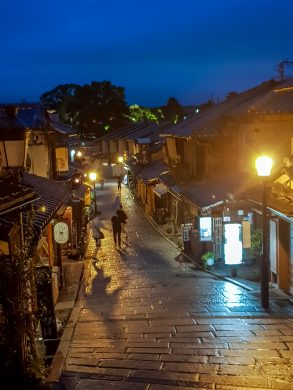 I was not giving up on seeing just one maiko. It would be nicer to speak to one but how? With the help of a tour guide who used to work inside a teahouse as an interpreter, was the answer to my question. We went to a teahouse in an alley where a maiko was performing. For a fee, the guide made the arrangement to introduce me to a lovely, young maiko so I could interview her. Her name is Fukuna. Fukuna could understand more English than she could speak so my guide was my interpreter. The young maiko was a bit shy but after our exchange of pleasantries she felt comfortable and interviewing her became like we were both telling stories to each other. Fukuna started laughing at my questions and with a hand gesture of agreement, she started to tell her story. According to her, most foreigners think that maikos are sold into the industry but it’s not true. As one of them, she chose to be part of this culture on her own. She came into the house of maiko at sixteen years old. She had no idea what to expect, the only thing she knew are the beautiful geikos on television, their beautiful, colourful kimono and so she dreamt of becoming one someday. She has been training as a maiko for four years now and she has two more years to become a fully-fledged geiko.
I was not giving up on seeing just one maiko. It would be nicer to speak to one but how? With the help of a tour guide who used to work inside a teahouse as an interpreter, was the answer to my question. We went to a teahouse in an alley where a maiko was performing. For a fee, the guide made the arrangement to introduce me to a lovely, young maiko so I could interview her. Her name is Fukuna. Fukuna could understand more English than she could speak so my guide was my interpreter. The young maiko was a bit shy but after our exchange of pleasantries she felt comfortable and interviewing her became like we were both telling stories to each other. Fukuna started laughing at my questions and with a hand gesture of agreement, she started to tell her story. According to her, most foreigners think that maikos are sold into the industry but it’s not true. As one of them, she chose to be part of this culture on her own. She came into the house of maiko at sixteen years old. She had no idea what to expect, the only thing she knew are the beautiful geikos on television, their beautiful, colourful kimono and so she dreamt of becoming one someday. She has been training as a maiko for four years now and she has two more years to become a fully-fledged geiko.
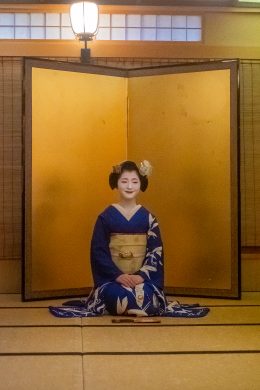
 Fukuna is just nineteen years old and is under the care of a okasan (house mother) in an Okiya or geiko house. The okasan (most of the time a retired geiko) is in charge of training a young maiko, teaching her dancing, singing, playing a musical instrument, studying Japanese tea ceremony and learning the rules to becoming a geiko. They are highly trained in etiquette. This was Fukuna’s life since she joined four years ago and would be for another two years. It was tough but also has its privileges such as dining in the best restaurants, wearing the most expensive kimonos and meeting very important people. It was a different life she had when she was still at her parents’ home. In today’s modern world when a Japanese girl want to become a maiko, she can just look up in the internet. During the olden times, someone of high status in society has to refer a girl to a tea house okasan to take her to become a maiko. The okasan becomes the surrogate mother of the maiko trainee. Fukuna’s first year was kind of hard, sad and lots of crying because she missed her family and friends but after a year she was adjusted and happy in the company of other maiko trainees who became like sisters to her. She can’t go home during her six years of training but her family can visit her once a month.
Fukuna is just nineteen years old and is under the care of a okasan (house mother) in an Okiya or geiko house. The okasan (most of the time a retired geiko) is in charge of training a young maiko, teaching her dancing, singing, playing a musical instrument, studying Japanese tea ceremony and learning the rules to becoming a geiko. They are highly trained in etiquette. This was Fukuna’s life since she joined four years ago and would be for another two years. It was tough but also has its privileges such as dining in the best restaurants, wearing the most expensive kimonos and meeting very important people. It was a different life she had when she was still at her parents’ home. In today’s modern world when a Japanese girl want to become a maiko, she can just look up in the internet. During the olden times, someone of high status in society has to refer a girl to a tea house okasan to take her to become a maiko. The okasan becomes the surrogate mother of the maiko trainee. Fukuna’s first year was kind of hard, sad and lots of crying because she missed her family and friends but after a year she was adjusted and happy in the company of other maiko trainees who became like sisters to her. She can’t go home during her six years of training but her family can visit her once a month.
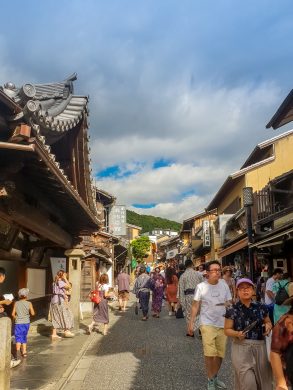 As a maiko trainee, Fukuna is not allowed to have a boyfriend, access to telephone, Facebook, McDonalds, Starbucks or even convenient stores. As a trainee, Fukuna doesn’t receive a salary. The okasan takes care of everything. From her hair, accessories, makeup, kimono etc. The training is quite rigid and challenging for Fukuna. Dancing is in slow move and controlled and her knees get sore. Serving tea is a challenge for there are several steps to follow. To top it all, her kimono weighs at least ten kilos and she had to learn how to walk in Okobo (wooden shoes as high as 10cm). She often twisted her ankle or fall as she was not used to it. During the day, she learns the ropes and at night performs at tea houses or in private parties or banquets. I asked Fukuna why her makeup is all white. She told me a bit of history that during the war, there were no electricity most of the time so in order for them to be seen in a dim light, they would wear white makeup and this became part of a tradition. She did her own makeup for thirty minutes now that she has a lot of practice. It used to be hours and hours of hit or miss and at first it was horrible.
As a maiko trainee, Fukuna is not allowed to have a boyfriend, access to telephone, Facebook, McDonalds, Starbucks or even convenient stores. As a trainee, Fukuna doesn’t receive a salary. The okasan takes care of everything. From her hair, accessories, makeup, kimono etc. The training is quite rigid and challenging for Fukuna. Dancing is in slow move and controlled and her knees get sore. Serving tea is a challenge for there are several steps to follow. To top it all, her kimono weighs at least ten kilos and she had to learn how to walk in Okobo (wooden shoes as high as 10cm). She often twisted her ankle or fall as she was not used to it. During the day, she learns the ropes and at night performs at tea houses or in private parties or banquets. I asked Fukuna why her makeup is all white. She told me a bit of history that during the war, there were no electricity most of the time so in order for them to be seen in a dim light, they would wear white makeup and this became part of a tradition. She did her own makeup for thirty minutes now that she has a lot of practice. It used to be hours and hours of hit or miss and at first it was horrible.
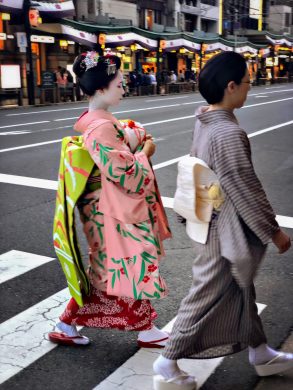 The hardest part is painting the nape with a shape. The purpose of this is to make the neck seem long like a swan as Japanese men prefer women with sexy long necks. She now can do it fast by using two mirrors one for the front and one for the back. When I ask her about her hair, she said that some maikos wear a wig but hers is natural. She goes to a specific hair salon to do her hair once a week and in order to keep their hairstyle perfect, she sleep with her neck on a small support, a Takamura or wooden pillow. Fukuna reminded me that she takes pride as a maiko, they are not out to sell their bodies as some people thought. For some, geikos and maikos are a shameful reminder of centuries old moral decline in Japanese society but in today’s society these geisha’s do not sell their body for money. It’s a glamorous job liken to the supermodels of today. It’s a chosen field amongst the young girls of 14 to 16. The idea of wearing a beautiful, colourful and priceless kimono is enough lure for these young girls.Some maikos graduate to become geikos but Fukuna has plans of getting married in the future.
The hardest part is painting the nape with a shape. The purpose of this is to make the neck seem long like a swan as Japanese men prefer women with sexy long necks. She now can do it fast by using two mirrors one for the front and one for the back. When I ask her about her hair, she said that some maikos wear a wig but hers is natural. She goes to a specific hair salon to do her hair once a week and in order to keep their hairstyle perfect, she sleep with her neck on a small support, a Takamura or wooden pillow. Fukuna reminded me that she takes pride as a maiko, they are not out to sell their bodies as some people thought. For some, geikos and maikos are a shameful reminder of centuries old moral decline in Japanese society but in today’s society these geisha’s do not sell their body for money. It’s a glamorous job liken to the supermodels of today. It’s a chosen field amongst the young girls of 14 to 16. The idea of wearing a beautiful, colourful and priceless kimono is enough lure for these young girls.Some maikos graduate to become geikos but Fukuna has plans of getting married in the future.
However, she can’t leave the house of maiko until she finishes her training for six years. When she become a geiko, she can talk to the okasan to release her but she has to pay for all the expenses during her training period. That will make them stay in the Okiya unless a wealthy man pays for her debt and become his wife. For now, Fukuna will concentrate on becoming a geiko. It is a beautiful world and she enjoys wearing very expensive kimonos and entertain in exquisite teahouses. She is an artist living in a world full of fascination, enchanted evenings and growth.



